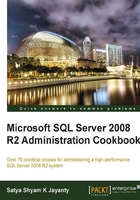
SQL Server 2008 R2 Parallel Data Warehouse
The SQL Server 2008 R2 Parallel Data Warehouse (PDW) is built upon a data warehouse technology that takes advantage to improve the reliability and performance of the instance that is highly scalable and built on a Massive Parallel Processing (MPP) and Symmetric Multi-processing (SMP) architecture to enable better administration, scalability of predictable performance, and reduced risk and lower cost per terabyte storage support with major hardware partner compatibility.
PDW provides the scalability and query performance by running independent servers in parallel, which means adding a CPU or memory capacity to the server is a straightforward process. SMP offers the ease of administration and MPP offers linear improvement in processing power, which is the scalability. To achieve scalable query performance, the appliance distributes data across multiple servers and SQL Server instances, and then uses its massive parallel processing (MPP) engine to execute queries in parallel.
The advanced data warehouse capability and standards of Star Join Queries, Change Data Capture, and integration with other Business Intelligence services such as SQL Server Integration Services (SSIS) and SQL Server Reporting Services (SSRS) are additional benefits. Appliance hardware is a multi-rack system with one control rack that controls appliance operations, and one or more data racks that store user data on multiple compute nodes. When designing your own appliance, you can scale out query performance and expand storage capacity by adding data racks.
SQL Server 2008 R2 Core Editions Enhancements
The Enterprise Edition is classified as a comprehensive data platform to meet the high demands of online transactional processing and data warehouse capabilities for all kinds of Enterprise-wide solutions.
There are new additions to these two core editions, which revolutionize the comprehensive solutions within the areas of availability, business intelligence, and scalability having built-in security features.
- Application and Multi-server management: This feature from the DataCenter edition is a new edition to the Enterprise Edition, which provides a drill-down capability of resources utilization of applications and instances. It provides the user with a central control to set up and enroll instances for policy evaluation and trend analysis of applications and instances to streamline the consolidation efforts management, which supports up to 25 instances.
- The Business Intelligence capability within Enterprise Edition includes the following key add-ins:
- PowerPivot add-in for Excel provides users to create effective BI solutions by supporting the seamless sharing of data models and reports through Microsoft Office SharePoint 2010 server.
- SQL Server Reporting Services Reporting Builder 3.0 is an ad hoc reporting client to accelerate the consistent process from report creation to collaboration to enable the rapid assembly of common business reports using the shared components, for a better scale-out deployment.
- SharePoint 2010 Operations Dashboard enables the users to monitor access and utilization of server resource usage, manage the right security privileges, and the ability to develop user-generated solutions.
- PowerPivot for SharePoint contributes to the ability to analyze the large volumes of data with a seamless integration with SharePoint Server 2010 to monitor and manage effectively.
- Master Data Services: It is a representation of a single version of data across the Enterprise. The master data hub facilitates the centralized approach to define, deploy, and manage master data efficiently in a consistent manner to enable a solution to create, manage, and circulate changes from a single-master view of multiple business entities.
- Unified Dimension Model: It is used to integrate and consolidate data from heterogeneous datasources such as SQL Server, DB2, SAP, Oracle, and Teradata.
- Scale-up and Scale-out: It features with an advantage of 64-bit technologies, which enables greater scalability with support for non-uniform memory access (NUMA) hardware without any application configuration changes. Hot-Add memory and CPU capability of Windows Server 2008 to scale up without having to stop SQL Server services.
- Improvements to Reporting Services with easier authoring and ad hoc reporting support for more data types, better control, and management of reports.
- StreamInsight: It processes large volumes with less latency; reduces the development and management costs to the benefit of near real-time event processing as a large-scale data platform. This feature is available for 64-bit and 32-bit platforms as a server and client packages with two different methods of installations—attended and un-attended.
- Live Migration: Windows Server 2008 R2 Hyper-V provides greater flexibility with Live Migration. Live Migration is integrated with Windows Server 2008 R2 Hyper-V and Microsoft Hyper-V Server 2008 R2. If the physical host that the VM is migrated to, is already clustered, then the VM will be automatically configured to be highly available and ready for Live Migration. See http://download.microsoft.com/download/4/4/D/44DB08F7-144B-4DF6-860F-06D30C6CE6E4/SQL%20Server%202008%20R2%20Virtualization%20Whitepaper.docx for more details.
- The new capabilities of the Standard Edition are as follows:
- Backup compression from Enterprise edition is now supported on every SQL Server 2008 R2 edition, with a limitation such as compressed and uncompressed backups cannot co-exist in a media set and previous versions cannot read the compressed backups.
- The Standard Edition can be a managed instance for application and multi-server management capabilities.